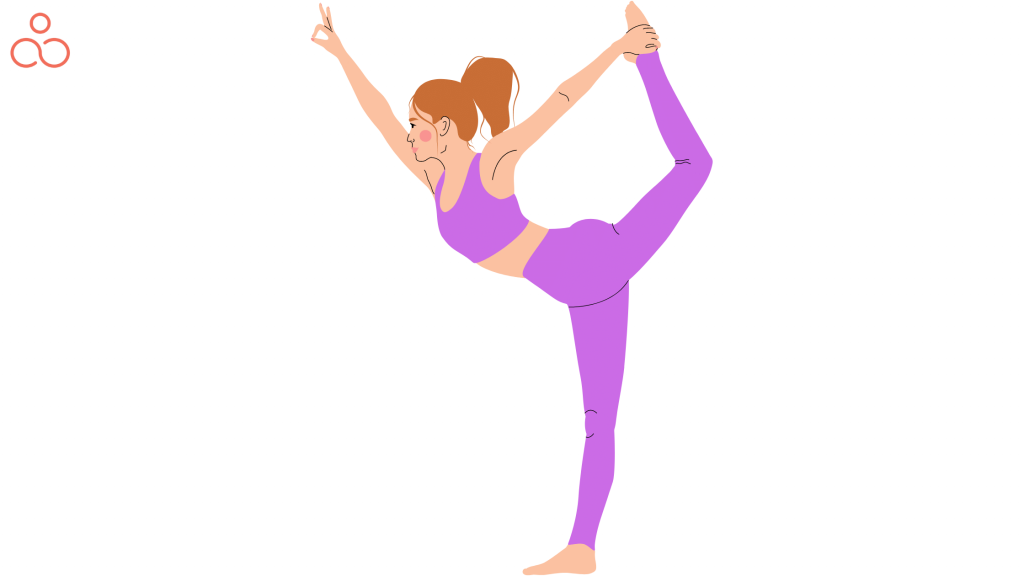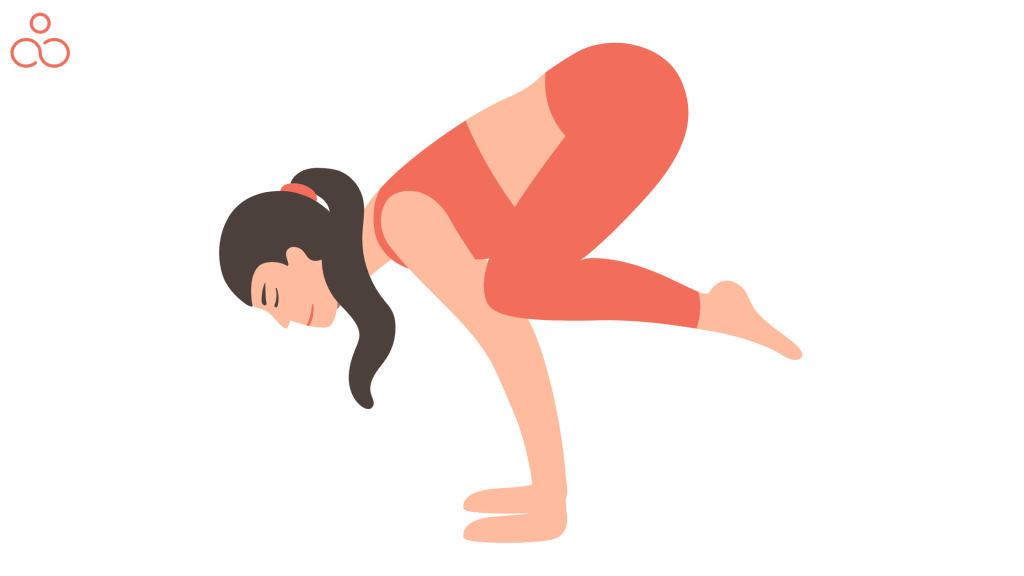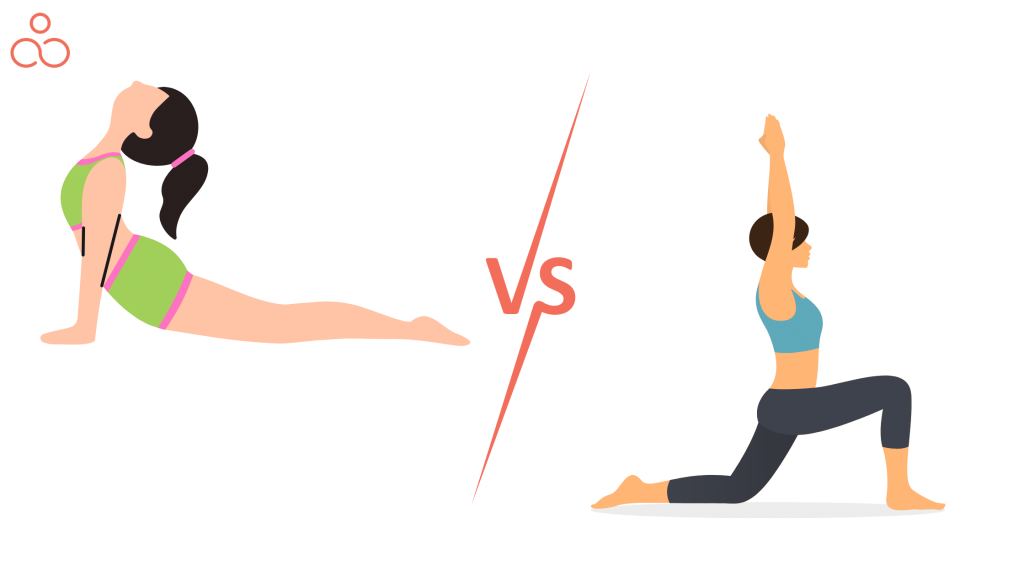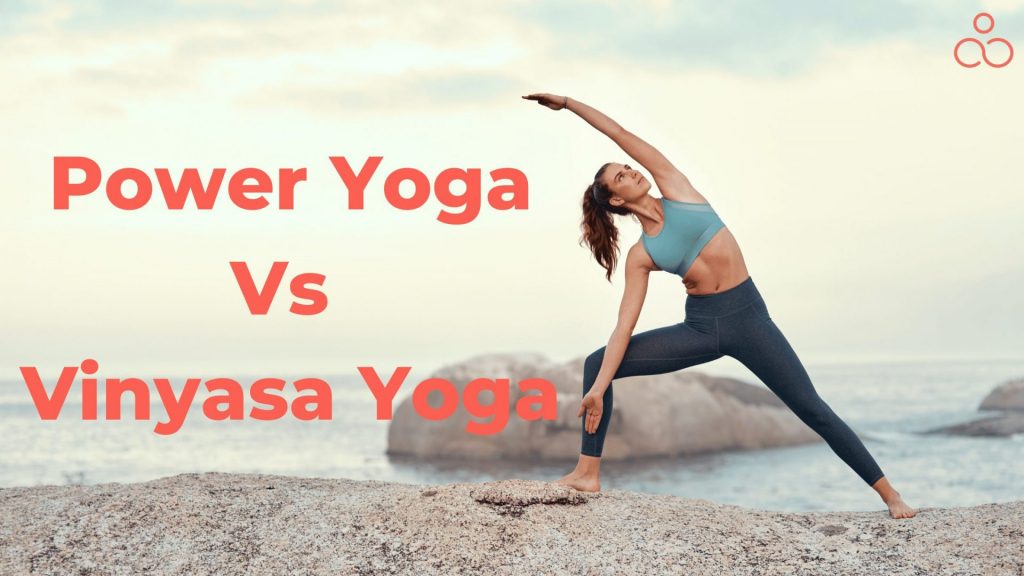Both Vinyasa and Power Yoga are excellent for enhancing your general health and wellbeing, but they have different sets of benefits as well as limitations. Vinyasa could be a better option for you if you want to connect more with the contemplative aspect of yoga where features like savasana and meditation are incorporated into the session. Power yoga on the other hand is a more athletic style of yoga and deviates a little from the fundamentals of conventional yoga.
So, let’s find out which one is best for you – Power Yoga vs Vinyasa Yoga!
What is Power yoga?

The best yoga style in the US is power yoga. It typically changes from course to course; the instructor is always in charge. Beryl Birch, Bryan Kest, and Baron Baptiste are regarded as the acknowledged founders of Power Yoga, which was created in the 1990s. The purpose of power yoga is to develop a lot of energy and strength. You will put in a lot of effort and break through to reach freedom inside yourself through working and discovering your actual self. Since Power Yoga is an arduous and hurried variation of traditional yoga, there have been instances when athletic and competitive people have been drawn to it.
Gym yoga is another name for power yoga. It is ideal for fitness enthusiasts who want intense lessons and enjoy working out. It is renowned for providing yogis with the perfect balance of energizing, exciting, and simultaneously soothing benefits. For the younger generation, yoga has been altered with vigorous and swiftly flowing variations. Power Yoga could be ideal for you if you want a mind-blowing, life-altering yoga experience.
A more intense variation of vinyasa yoga is power yoga. It originally resembled Ashtanga yoga but was modified to be more approachable for fresh western students and gym users. Before enrolling in a class, be careful to verify with the instructor or studio as each one may have a different teaching approach.
Benefits of Power Yoga
If you’re anything like the majority of people, you probably envision yoga as a peaceful, unwinding method of stretching your muscles and increasing your flexibility. Power yoga, on the other hand, is a different style of yoga that provides a considerably more demanding workout. Traditional yoga positions are combined with cardiovascular training in the fitness-based style of yoga known as power yoga. Here are three advantages of power yoga that will assist you in losing weight and enhancing your general health:
- Strength and Endurance: Power yoga is a great exercise for increasing strength and endurance. You’ll tone your muscles and increase your endurance, thanks to the nonstop movement and difficult positions.
- Weight Loss: Power yoga might be a useful strategy if you’re trying to reduce weight.
- Stress Reduction: Power yoga has several physical and mental health advantages. It may also help you manage stress and enhance your mental health.
- Improves Sleep – The intense workout sessions and the tough training naturally improves your sleep cycles and help you to feel refreshed and rejuvenated every morning.
- Controls Health Conditions – Power yoga helps improve cholesterol levels, controls high blood pressure, and moderates blood sugar levels.
Limitations of Power Yoga
Fitness requirements for power yoga exist. It is without a doubt yoga in its most athletic form. Power yoga is probably not the ideal option for you if you prefer a more relaxed and restorative practice. Vinyasa would better suit your needs if you want to start practicing yoga but haven’t given your health much of a priority in the past. Some of the drawback of Power Yoga are:
- Durations of sessions: Long durations of sessions make it difficult for most of the people to stay committed. Certain sessions are almost 90 minutes.
- Environment – Power yoga is a fast-paced and intense workout technique. Adapting to that environment is really important as it could be really challenging to get the right trainer who could set you on track without any irritations
- Yoga Newbies- Most of the people who are new to fitness or yoga might find it difficult to start their journey with power yoga. They find it confusing, challenging, and even end up losing the motivation factor.
If you are interested in a power Yoga session, watch this video.
What is Vinyasa yoga?

Vinyasa means “to put in a unique way” in Sanskrit. As you move through the session, the positions in this type of yoga grow more and more difficult. Yoga sessions with a progressive flow are sometimes referred to as vinyasa classes.
Vinyasa is fantastic since it doesn’t have a predetermined sequence of exercises to follow. Therefore, each class is unique. Vinyasa is excellent for enhancing balance, strength, and endurance. You might certainly classify it as a lower-intensity kind of exercise, but don’t worry—doing this kind of yoga will still likely raise your heart rate. The progressive motions used in a Vinyasa class are a fantastic method to raise the heart rate to the equivalent of a light-intensity cardio workout, according to 2013 research by the Journal of Yoga & Physical Therapy. Still further research needs to be done to characterize the individual response.
It may not raise your heart rate like a strenuous cardio class or target a specific muscle region like a weight training regimen, but it does develop total-body strength and endurance. In a yoga lesson, every muscle in the body must be engaged. As a result, you will get a more balanced body composition than you would if you only did cardio or weight training.
Benefits of Vinyasa Yoga
Everyone is aware that Vinyasa, also known as flow style yoga, has several advantages for a person.
- Perfect Cardio – One of the yoga forms noted for burning the most calories is vinyasa, which makes it a fantastic cardio exercise.
- Weight Loss – It promotes calorie burning, which can greatly aid in weight reduction and weight management. An individual may often burn 450 calories or more by participating in a 1-hour fast-paced Vinyasa practice.
- Strength and Endurance – Vinyasa yoga is renowned for enhancing physical power, mental clarity, flexibility, and cardiovascular health. Vinyasa yoga significantly increases a person’s upper body strength, assists with muscular toning, and improves functional strength. Vinyasa yoga aids in developing strong, slender muscles all over a person’s body.
- Alleviates Stress – Vinyasa yoga is another practice that has a reputation for helping people manage their stress. Additionally, it aids in normal breathing, which has a significant impact on the respiratory system and leads to healthy lungs.
Limitations of Vinyasa Yoga
Just like every other style of yoga, vinyasa flow has also earned its share of criticism:
- Alignment – The flow from one pose to another creates a rhythm that tends to force you to keep moving even before you master or achieve the right body alignment. Without achieving the correct alignment, you might find the entire practice ineffective.
- Postures – Understanding each posture is practically not possible and gaining knowledge on them is not an ideal agenda of vinyasa. This technique has an underlying criteria for its practitioners to be aware of the postures and a certain level of alignment.
- Repetitiveness – The vinyasa flow as the name suggests, has a series of poses that are practiced on loop. I personally get very bored doing the same sequences over and over again.
If you are interested in a Vinyasa flow Yoga session, watch this video.
Vinyasa yoga vs. Power yoga: Key contrasts

There are many distinct varieties of yoga, but vinyasa and power yoga are two of the more well-liked styles. Although both methods may deliver a demanding exercise, there are some significant distinctions between them. The following four considerations will help you choose the best kind of yoga for you:
- Vinyasa yoga is physically less taxing than power yoga. Longer holds and more challenging positions are included. Power yoga could be a fantastic option if you’re searching for a more difficult workout.
- Sun Salutations are a common part of vinyasa yoga, which is more fluid. Vinyasa yoga can be a better choice if you’re searching for a less demanding exercise routine. While vinyasa yoga is not often taught in a hot environment, power yoga is. Power yoga is the best option if you’re seeking a heated yoga class.
You may adapt either yoga technique to your degree of fitness. Be careful to inform your teacher of any ailments or injuries so they may assist you in adapting the postures as necessary.
Which one suits you the best
Power yoga is for you if you want an aggressive workout that will have you sweating away extra body fat, tightening your abs, sharpening your mind, and toning up your muscles. It combines fitness with spirituality.
Vinyasa is a more accessible kind of yoga than power yoga. It is best for you if you’re seeking a flexible style that is suitable for beginners. Vinyasa emphasizes flow.
You allow the energy to softly flow through your body as you transition from one posture to the next.
Your best strategy is to give both vinyasa and power yoga a try before making your decision. Try vinyasa yoga if the power yoga’s rapid tempo is too demanding for you. Vinyasa is more popular since it is gentler on the joints.
You can’t go wrong with either sort of yoga since practicing any kind of yoga is a terrific decision. As you start your yoga practice, it’s best to concentrate on one type; as you advance, you may always try the other styles.
Vinyasa courses are a good place to start for new students. This method is excellent for learning the fundamentals of yoga with a dash of meditation components. Let’s not forget that yoga works the mind as well as the body, and meditation is a key component in working the mind. So, embrace the mental aspects of yoga without fear.
Whichever route you take, we advise that you attend class in person when it resumes. Understanding the proper form and alignment in postures requires attending in-person courses. You might want to try Power yoga if meditation and slower progressive lessons don’t seem like your cup of tea. Ashtanga is also a component of power yoga. Your age, level of fitness, and the goals you have for practicing the type of yoga you choose will all play a significant role in determining which yoga is best for you.
Final thoughts on Power yoga vs Vinyasa yoga
The practice of power yoga and vinyasa is similar. However, there are certain distinctions between the two in general: Compared to Vinyasa yoga, which moves the postures swiftly like a dance sequence, power yoga has fewer poses and holds them for a longer period. Power yoga’s lengthier holds in the poses reflect its greater emphasis on enhancing strength when it comes to flexibility and strength. Vinyasa, on the other hand, focuses on improving a person’s flexibility since the postures are performed in a fluid, continuous movement. When it comes to the body and breathing concepts, vinyasa is more concerned with the breathing technique whereas yoga places a greater emphasis on the individual’s body. Hence, now it’s up to you to pick a style and embark on your yogic journey!

